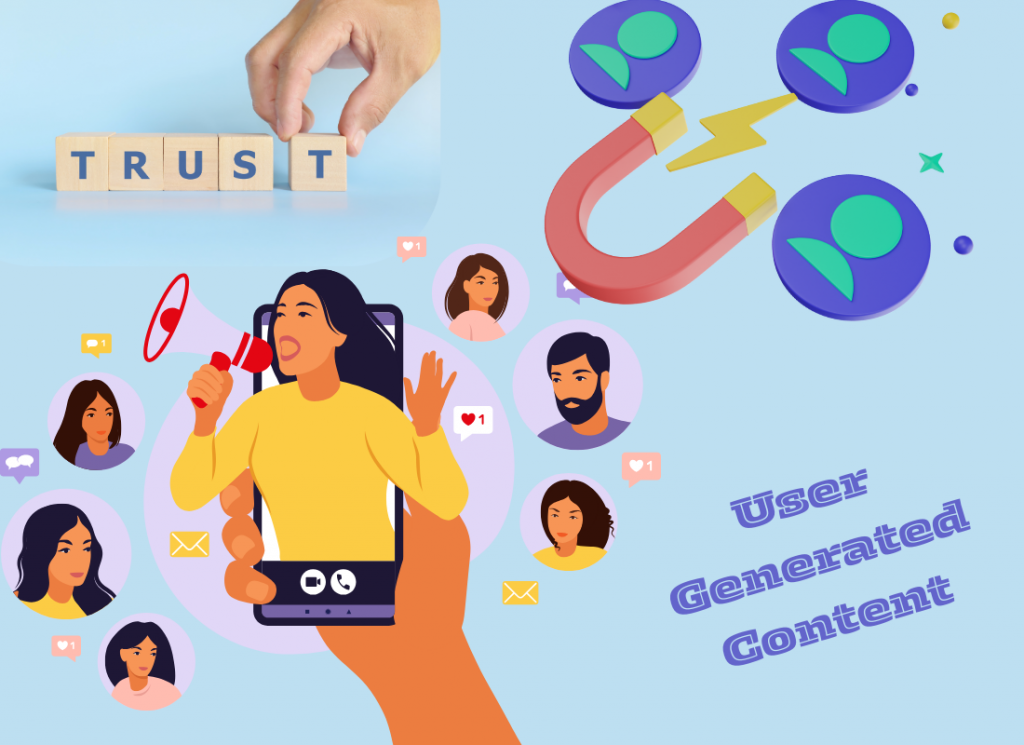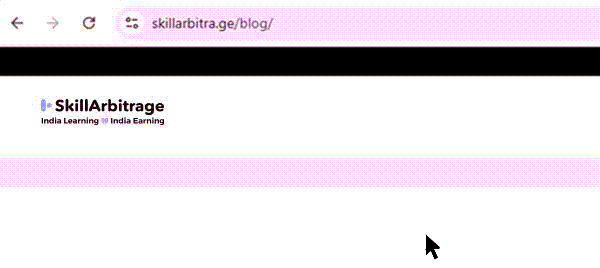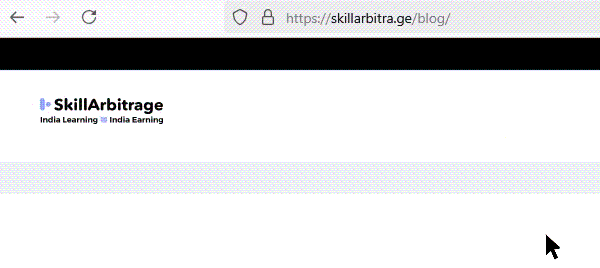This blog is all about the power of UGC (User Generated Content) in marketing communication. It provides practical tips on writing of the content and will come in useful for content marketers, strategists, and content writers.
Table of Contents
Introduction
Why does anyone buy anything?
The answer is not very complex. People generally buy two kinds of things: 1) things they need, 2) things they want.
There are a thousand different reasons to describe why a consumer keeps buying from a certain brand, but one standout reason is trust.
We tend to buy things from people (brands) we trust.
For years, brands have spent crores to find the marketing equivalent of this philosopher’s stone. They tried brand ambassadors, celebrities, models, and relatable advertising to achieve this.
Do you know what it ultimately boiled down to?
It turned out that people trust people above all else.
Look at the screenshot below.
(Source: https://www.tintup.com/state-of-community-powered-marketing/)
This is the power of user-generated content.
If leveraged properly, user-generated content in all its forms, like reviews, unboxing videos, shout-outs by influencers, testimonial videos, and blogs, can cut a brand’s marketing budget by at least half.
Take a look at the latest data.
(Source: https://backlinko.com/ugc-statistics)
Big and small brands have successfully used UGC as a crucial part of their marketing strategies across marketing channels.
Generated using Claude.ai
Curious cases of brands using UGC
Coca-Cola’s Share a Coke
In 2011, the beverage giant Coca-Cola launched a campaign. They put some common names in their packaging and urged consumers to purchase the bottle with their name on it, take a picture, and post on social media. This campaign made the internet stand still for some time.
People went wild at the sense of personalized bond the brand created and flooded the internet with authentic, genuine photographs.
What did the brand gain?
This is a screenshot of a report published by Coke.
The psychological impact was even more powerful.
People instantly felt recognized. The fun aspect of finding a bottle with your name made it engaging and compelling. In short, this was a simple and easy yet challenging thing to do! As you can see, the campaign went on to create history.
Can you replicate this for a smaller brand?
The only advantage Coca-Cola had over a smaller brand was its huge logistical support. But say someone has a small lipstick brand. Can they urge consumers to write a powerful slogan on the bedroom mirror and share a selfie with it, lipstick in hand?
You bet they can. If done properly with a good social media campaign, it can create a memorable impact and ensure repeat sales as well as new conversions.
If we take away the label printing and the mall collaboration part that Coca-Cola leveraged to connect to people, the beauty of the basic idea remains the same.
It was a device for the consumer to feel that a bottle of their favorite soft beverage had been created keeping them exclusively in mind. This intimacy is something that goes far beyond the price tag, and an idea made it all happen.
As long as there is relevance, excitement, and an easy CTA, people will engage.
Airbnb’s Live There Campaign
With the “Live There” campaign, Airbnb set itself firmly apart from the traditional hospitality niche.
They urged people to “live there” instead of simply “visiting” or “doing” their preferred travel destinations. They emphasized the value of imbibing local customs and sampling local cultures over taking selfies with crowded tourist favorites.
(Source: https://youtu.be/ddRBr2It00k?si=R7IzB4NwGakgM42x)
With a series of user-generated videos, Airbnb showcased authentic and immersive travel experiences, ranging from idyllic time spent at a treehouse in Costa Rica to exploring hidden gems in Tokyo’s bustling neighborhoods.
Their campaign philosophy was described beautifully in the captions the brand shared with the user-generated content.
What did the brand gain?
According to a report from Medium, after the campaign saw the light of the day Airbnb’s brand awareness increased by a whopping 9%, while their social media engagement increased by 15%, with user-generated video content receiving almost 1.5 million likes, shares, and comments in total.
But it does not stop with likes and comments, the campaign also resulted in an up to 20% increase in sales when compared to the other marketing initiatives.
Can you replicate this for a smaller brand?
The “Live There” campaign like most successful campaigns, is simple to the extreme. It takes Airbnb’s USP (Unique Selling Point), which is accommodation in individual homes rather than hotels, and weaving a campaign around it by leveraging excellent storytelling techniques.
Coming back to the small lipstick brand we were talking about, can you take a USP let’s say “wear it anywhere”, which to be fair is applicable for most lipstick brands out there, and ask the buyers and followers to share the videos of regular activities like cooking, grocery shopping, working on their laptops, wearing this specific brand of lipstick?
Yes, you can! Not only is it a fun and engaging contest, but it also reinforces the message that these are lipsticks that can be worn by anybody, at any time!
Done properly, this will help increase the potential consumer base along with grabbing a lot of eyeballs.
ALS Ice Bucket Challenge
The iconic ALS Ice Bucket Challenge was founded by Pat Quinn and Pete Frates to raise awareness and funds for organizations that help individuals with amyotrophic lateral sclerosis (ALS).
The idea again was simple: Raise awareness of ALS by encouraging the audience to use smartphone cameras to capture and distribute videos of friends, colleagues, and celebrities pouring ice water on themselves.
What did the brand gain?
The campaign led to an extensive reach, flooding social media for months. It generated 2.4 million tagged videos on Facebook alone and raised $220 million for ALS organizations.
To this day, this campaign remains a gold standard for campaigns built on User Generated Content.
Can you replicate this for a smaller brand?
This campaign was all about raising awareness. Can you devise a campaign around “ Gift a lipstick, gift a smile” in which women have to gift a lipstick to a neighbor, friend, employee, or domestic helper for Women’s Day and share the stories with a picture of the recipient holding the lipstick in hand?
This can and will raise awareness about your brand and working women who support each other.
It is not difficult at all, as you can see!
Where can you display UGC?
Here are the places where you can effectively display your user-generated content.
Social media spotlights
Feature customer reviews, testimonials, or photos in Instagram Stories, Twitter retweets, or TikTok duets. Highlight real customers using your products, making your brand more relatable.
Tourism Australia has followed this to make itself an Instagram sensation. Their #SeeAustralia hashtag has over 141 million views on TikTok and is attached to over 6 million pieces of UGC on Instagram.
(Source: https://www.instagram.com/australia/)
Website galleries & reviews sections
Create a dedicated section on your website where customers can share their experiences. A well-curated gallery of customer photos or a “Wall of Love” featuring real feedback can build credibility.
Calvin Klein, among many, has successfully done this. #MyCalvins is a UGC campaign created by Calvin Klein in which the famous fashion brand asks users to post pictures of themselves wearing apparel and accessories from the brand. The campaign has a separate landing page where the highlights are shared.
(Source: https://www.calvinklein.us/en/mycalvins.html)
Email campaigns
Make your promotional emails more persuasive by embedding UGC. Feature a happy customer’s review or a user-submitted photo to encourage others to trust your brand.
For emails, sometimes you also have to write success stories. These are not user-generated content per se, but experiences of users that can be written in a story format.
There are two great frameworks you can use to write success stories or experiences of consumers.
To explain how it is done, let’s assume we are writing user experiences for the hypothetical lipstick brand we were using a while back.
First: The Story Brand framework
This framework was first introduced by David Miller in his book, Story Brand.
It posits the theory that the consumer is the real hero and not the brand. The brand only aids them in their journey, like the faithful Samwise Gamgee was to Frodo when he embarked on the journey to destroy the ring in Tolkien’s famous The Lord of the Rings.
This framework has 7 parts:
Here is an example.
Character: Your target customer
A job-holding woman in her 20s – 30s.
Problem: The challenges
She is a go-getter, someone who is quickly climbing up the corporate ladder entirely on merit. She also balances her roles as a wife and mother perfectly with her job, but this leaves her with very little time to spend on her appearance. She is looking for a perfect lipstick brand that will last all day without having to refresh constantly and yet have cool, fun shades to offer.
Guide: You
Then, she came across a new lipstick brand from a ton of positive reviews on social media. It seemed to last really long and offered shades suitable for office as well as fun outings and date nights with her spouse/partner.
Call to action
She visited the online shop to see the shades and was amazed at the range! Visit us now to choose your shade!
Avoids failure: how they avoid failure by staying with you
She tried it for herself and now she can look as fashionable as she wants, everywhere and all the time!
Achieves success: how they achieved success by staying with you
She is now a fashionista as well as a super successful employee at work now! The lipstick not only upped her fashion game but also boosted her confidence. She can now do anything she wants.
The whole point of using this framework is to establish the product/brand as an irreplaceable part of the target customer’s dream outcome.
Second: The Story Spine or Pixar framework
This framework was developed by Emma Coates at Pixar. It is a classic storytelling tactic that clicks really well with audiences across demographics. It works because of its super-effective sequence.
Take a look at it.
Here’s the format, along with an example:
Once upon a time: target customer is introduced
Once upon a time, there was a young woman called Priya Mathur who started her new job as a journalist. She had big dreams of becoming someone in the world of electronic journalism, and her secret dream was to become a News Superstar.
Every day: routine challenges
Each day, she would try to drum up the courage to apply for the news anchor position, and every day, her lack of confidence about her own appearance would hold her back. She grew more and more discontent.
One day: the routine gets broken
One day, one of Priya’s friends told her about an amazing lipstick brand that she, the friend, had been using for some time. The lipstick lasted really long and came in a bunch of amazing shades suited to every skin tone. Curious, Priya looked at the range online and ordered one for herself.
Because of that: consequences
When her lipstick arrived and Priya put it on, for the first time in the mirror, she saw a confident young woman who could easily be a new anchor.
Because of that: success/failure
That day, buoyed by her new courage, Priya decided to apply for the news anchor position. Something she had been deliberating for the past several weeks.
Finally: the climax
As a result, she got called for auditions and managed to crack it, landing her coveted news anchor role.
And ever since that day: a new routine
Since that day, Priya has gone from strength to strength. Every day she takes on new challenges and thanks heavens for coming across that lipstick that would never let her down, ever.
Shoppable UGC
Turn user photos and videos into clickable shopping experiences. If a customer posts about your product, link it directly to your e-commerce store for an easy purchase journey.
In-store or event displays
For offline businesses, showcase UGC on digital screens in-store or at brand events.
Generated using Claude.ai
Why UGC works: The psychology behind consumer trust
Social proof & trustworthiness
As we saw, consumers trust peer reviews more than branded content.. Seeing others use a product fosters trust and reassures potential buyers.
The FOMO (Fear of Missing Out) effect
UGC campaigns that can drive a huge response create a sense of urgency for other consumers, leading to massive consumer engagement.
Relatability & community engagement
Liking for a specific group creates a bond among people, especially valuable in these times of alienation.
Generated using Claude.ai
What to do to start your own UGC campaign?
There are various ways of doing this, but generally, you need to follow these steps.
- First, sit down and devise a campaign and its relevant hashtags. Make sure to make the campaign logistically easy and engaging at the same time. Then conduct some research to find out that the hashtag is not being used by any other brand. This is why hashtags with the name of the brand in it, work.
- Remember that the campaign doesn’t always have to be about the product. It can be about a feeling that reminds the consumer of the product.
- Secondly, start the campaign with precise and simple instructions on your social media channels and, if possible, add some reward to lure the users to generate the content for you. Even the promise of a shout-out can work as a reward. Then, keep the instructions in a bio or a pinned post so that whoever visits your page/profile takes a look at it first.
- Thirdly, start tracking the hashtag daily and sharing the curated user-generated content across your channels of distribution, as shown in the earlier sections.
- Fourthly, repurpose the content on your website, blog, emails, etc.
The biggest challenges of UGC marketing and how to navigate them
While UGC is a powerful tool, it comes with its own set of challenges. The most common ones are these:
Quality control & brand consistency
Not all UGC is fit to be endorsed by a brand. UGC varies in quality and may not always align with a brand’s aesthetic or messaging.
Implementing strict content guidelines and quality checks can help with the curation.
Negative or inappropriate content
The beauty of UGC is that it is unfiltered. But that same attribute has its own set of challenges. Negative reviews or inappropriate content can surface and damage the brand’s reputation.
Active social media monitoring can help with this. Instead of deleting negative reviews, brands could also engage constructively and hear out the concerns. An empathetic attitude always helps.
Copyright & legal issues
This one is a biggie. Using UGC without clear consent is a surefire way to land in a legal soup.
Brands often use UGC without clear permission, leading to copyright disputes and legal risks.
Always obtain explicit permission from creators before repurposing UGC and implement user agreements that grant rights to use submitted content.
Low user participation
This is a very common phenomenon. A lot of brands struggle to engage current and potential customers to create and share content.
It’s a different thing when you are a big brand like Calvin Klein or Airbnb, but for smaller and newer brands gathering enough users to generate the content can be a challenge.
Smaller brands can boost participation by offering incentives such as contests, discounts, and shout-outs to encourage users to contribute.
Measuring ROI & effectiveness
Tracking the success and impact of UGC can be a complex process. Using advanced analytics tools to track metrics like engagement, conversion rates, and user sentiment to quantify UGC success are the most common practices.
Generated using Claude.ai
Future trends in UGC
Here are some of the trends that will rule this specific marketing style in the near future.
AI-driven personalization
More and more AI-powered tools will be used to curate personalized UGC recommendations based on user behavior.
Short-form video dominance
Platforms like TikTok and Instagram Reels are driving UGC adoption through short, engaging videos.
Micro-Influencer partnerships
Brands are increasingly collaborating with micro-influencers to generate authentic, community-driven content.
UGC in virtual & augmented reality
With the rise of the metaverse, brands will leverage UGC in immersive digital experiences, increasing the impact manifold.
So now you know all about UGC campaigns, including how to start your own and where to distribute it. Try them out and see how they work, and let us know your experiences in the comments.
FAQs
1. What is User-Generated Content (UGC)?
UGC refers to any content, such as reviews, social media posts, videos, blogs, and images, created by users, customers, or fans of a brand rather than the brand itself. It serves as an authentic, peer-driven endorsement.
2. Why is UGC important for brands?
UGC builds trust, fosters engagement, and provides social proof, making marketing more relatable and credible. It also saves costs on content creation and helps brands connect with their audience on a deeper level.
3. What are the different types of UGC content?
- Customer reviews and testimonials
- Social media posts (images, videos, stories, reels)
- Blog posts or guest articles
- Unboxing and product demo videos
- Community discussions and Q&A forums
- Hashtag campaigns and brand challenges
- Influencer and micro-influencer collaborations
4. How can brands encourage users to create content?
- Create branded hashtag challenges
- Offer incentives like discounts, giveaways, or shoutouts
- Run contests and UGC campaigns
- Feature user content on social media and websites
- Engage with and appreciate user posts to encourage more contributions
5. What platforms are best for UGC marketing?
Popular platforms for UGC include:
- Instagram & TikTok – Ideal for visual and video content
- YouTube – Great for in-depth reviews and testimonials
- Facebook & LinkedIn – Best for community-driven discussions
- Twitter/X – Ideal for short-form engagement and brand conversations
- Reddit & Quora – Effective for in-depth user discussions and problem-solving
6. How can businesses repurpose UGC for maximum impact?
- Feature UGC in paid ads and organic posts
- Use customer testimonials on landing pages
- Include UGC in email marketing campaigns
- Repurpose video content into reels, shorts, or GIFs
- Compile UGC for brand storytelling or case studies
7. What are the benefits of UGC over traditional marketing?
- More authentic and relatable than branded content
- Higher engagement rates
- Cost-effective marketing strategy
- Boosts brand credibility and trust
- Expands brand reach organically
8. How can brands ensure UGC aligns with their messaging?
- Set clear campaign guidelines
- Provide inspiration or examples of the type of content desired
- Engage and interact with users creating UGC
- Curate and moderate content before sharing
9. How do you measure the success of a UGC campaign?
- Engagement Metrics: Likes, comments, shares, and saves
- Reach & Impressions: How many people see the UGC
- Conversions & Sales: How UGC impacts purchase decisions
- Brand Mentions & Sentiment Analysis: Tracking brand reputation
- User Participation Rate: Number of people contributing content
10. What are some successful examples of UGC campaigns?
- Coca-Cola’s ‘Share a Coke’ Campaign – Personalized bottles encouraged users to share photos
- GoPro’s Customer Video Contest – Fans submitted adventure clips shot on GoPro
- Starbucks’ Red Cup Contest – Customers posted creative coffee cup photos
- Airbnb’s Travel Stories – Users shared real experiences, making marketing more authentic
11. How does UGC impact SEO and website traffic?
UGC boosts SEO by:
- Increasing fresh, keyword-rich content
- Enhancing social proof through user interactions
- Generating backlinks when users share content
- Improving time spent on site through interactive content
12. How can brands moderate and manage UGC effectively?
- Use content moderation tools to filter inappropriate content
- Set clear UGC submission guidelines
- Engage with and reward high-quality content
- Have a dedicated team to review and approve content
13. What legal considerations should brands keep in mind with UGC?
- Obtain explicit user consent before using their content
- Give proper credit to content creators
- Be aware of copyright and intellectual property laws
- Include terms and conditions for UGC submissions
14. How can businesses turn UGC into a community-building tool?
- Create a branded community hashtag
- Feature user content on official pages
- Build an exclusive loyalty program for contributors
- Engage in real-time conversations with UGC creators
- Celebrate top contributors with shoutouts or incentives
15. What are the common mistakes brands make when using UGC?
- Failing to get user permission before reposting
- Ignoring negative or low-quality content instead of addressing it
- Over-relying on UGC without balancing it with brand content
- Not engaging with users who contribute content
- Lacking a proper strategy to track and measure UGC performance







 Allow notifications
Allow notifications
